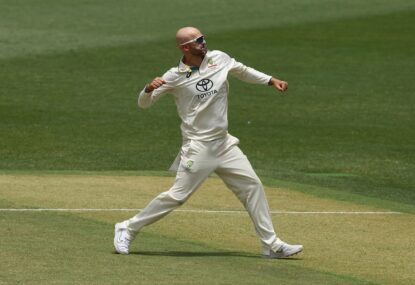Sometime during 1932, just months before the infamous Bodyline series, England’s captain Douglas Jardine went to the home of a shady former cricketer called Frank Foster in the upmarket London suburb of Belgravia.
Jardine was an Oxford graduate and mixed in high society circles, but the purpose of his visit was not a social call.
He was a desperate man, and he needed Foster’s help to hatch a plan.
Born in Birmingham, Foster was a former Test cricketer who had employed unusual methods to bowl England to victory in the 1911/12 Ashes series in Australia. (After his career ended, he had descended into a life of gambling and sordidness, and he was even questioned over an unsolved murder).
Jardine wanted his advice on how to dismiss 24-year-old batting sensation Don Bradman, who had almost singlehandedly secured an Australian win in the 1930 Ashes series.
The plan Jardine and Foster came up with involved placing most of the fielders on the leg-side and instructing the English fast bowlers – most notably Harold Larwood – to aim short-pitched balls at the Australian batsmen’s bodies.
The intention was to force them into making defensive shots and getting out caught by a ring of fielders close to the bat. The strategy relied partly on fear. If the batsmen missed, they ran the risk of getting hit in the chest.
While the plan – which would become known as bodyline – was a stunning success, it has remained controversial ever since. Foster himself disowned it, and the rancour it produced forced cricket’s authorities to change the rules of the game to prevent any repeats.
But would bodyline have worked against Steve Smith?
Not since Bradman’s day have English cricketers confronted a batsman as apparently immovable as the former Australian captain.
Smith is now only the fifth Australian player to score a century in each innings of an Ashes Test match – something Bradman himself never achieved – and his feats have left many players and pundits scratching their heads about how to get him out.

(Photo by Gareth Copley/Getty Images)
The problem for bowlers is that Smith is a highly unorthodox player with no obvious weaknesses.
His batting stance has become increasingly characterised by an early motion across his stumps as the ball is delivered. It leaves him looking awkward, almost as if he were playing French cricket.
It is the type of movement that would make a less gifted player highly vulnerable to getting out LBW, but Smith has not shown the slightest hint of missing, even when the ball swings late.
Instead, Smith’s shuffle allows him to hit deliveries on the line of off-stump through mid-wicket, or pull straight balls through square leg. Rather than play towards the ball from inside the line, his bat at times seems to come from outside it, thus reducing the likelihood of nicks to the slips from defensive prods.
Batting coaches have long emphasised the importance of playing the ball close to the body, of getting your head over the ball and closing the gap between bat and pad.
Smith, however, defies this logic. He seems capable of playing an array of shots regardless of the line and length of the delivery.
During his television commentary, Kumar Sangakkara said the position of Smith’s body in relation to the ball made no difference to the type of shot he played. This is, quite simply, extraordinary.
The game of cricket has changed a great deal since the Bodyline series. Bowlers are no longer allowed to pack the leg-side field, and batsmen have substantially better protective equipment.
However, watered-down versions of bodyline bowling have continued to crop up every now and again, and the question of whether the plan would work against Smith has – to a small extent – already been answered.
In Smith’s third Test match, against England at the WACA Ground in 2010, he was submitted to a barrage of short-pitched balls by towering English paceman Chris Tremlett.
In his report on the match for Wisden, veteran cricket writer Scyld Berry went so far as to describe Tremlett’s tactic as bodyline.
“An unusual feature of this match, a consequence of the pitch regaining some of its famous bounce, was that one bowler from each side tried an over of bodyline – short balls rather than outright bouncers – from around the wicket,” Berry wrote.
After Peter Siddle attempted it for Australia, “Tremlett responded by doing the same to Smith – and [got] him caught gloving down the leg-side.”
At that stage of his career, however, Smith was being picked as a leg-spinning all-rounder, and there was no hint of the run-scoring machine he would become.
Four years after that Perth Test match, Smith was at the non-striker’s end when Indian paceman Varun Aaron attempted a similar approach to that of Tremlett, when he bowled to Michael Clarke at Adelaide Oval.
At the time, on-field umpire Ian Gould jokingly told Clarke to get ready for a “bit of bodyline, son”.
While the short-pitched bowling was primarily aimed at Clarke, Smith also received several bouncers during the same period of the match.
This time, however, he was more than up to the challenge and went on to make 162 not out. This innings alone suggests Smith is not likely to be challenged by sustained leg-side attacks.
To work, bodyline requires bowlers with express pace, which the current English side lacks.
That pace could be provided by Jofra Archer or Mark Wood.

(Mike Hewitt/Getty Images)
However, a more fruitful method of trying to dismiss Smith might be to bowl fuller, rather than short-pitched, balls at leg stump from around the wicket.
This last point – the line of attack – is potentially crucial.
The orthodox view is that around-the-wicket fast bowling to right-hand batsmen should only ever be done by left-arm seamers. Right-arm bowling creates too much of an angle across the batsman and removes the possibility of LBW dismissals – or so the thinking goes.
Sadly, this view seems to have been accepted uncritically.
In reality, there is no reason why the likes of Stuart Broad and Ben Stokes should not at least try the tactic when bowling to Smith.
West Indian speedster Malcolm Marshall – a right-armer – loved bowling around the wicket to right-handers, believing it allowed him to intimidate by directly attacking the batsmen’s ribs.
“I may be wrong,” Jardine wrote in his book In Quest of the Ashes, “but I have a strong suspicion that it is easier for the batsman to decide what ball is just outside the off stump, and consequently need not be played, than for him to make up his mind about the course of the ball which pitches the same distance outside the leg stump.”
He added: “There is the obvious danger of the batsman being bowled off his pads – an additional reason why the leg ball demands active treatment.”
Smith’s initial motion at the crease could expose the leg stump, and England’s pace attack should attempt to effectively bowl him around his legs, or use the change of angle to induce an error.
This would, of course, be playing to Smith’s strengths – he is probably the most brutal punisher of stray bowling on leg stump since India’s VVS Laxman.
Furthermore, history suggests it may not work. Two and a half years ago, Smith plundered a Pakistani pace attack that included at least two, and sometimes three, left-armers bowling around the wicket.
Jardine himself cautioned against a poorly executed leg-side attack.
“Badly bowled leg theory, consisting of occasional long hops, full pitches, and half volleys, must surely be the batsman’s dream come true,” he wrote.
But, as players including Ricky Ponting have demonstrated, strengths can sometimes become weaknesses. For most of his career, Ponting loved to play across the line of the ball through midwicket, but found himself increasingly susceptible to in-swingers into the pads as he entered his twilight.
At Edgbaston, England’s seamers looked most dangerous when they pitched the ball up.
Where Smith is concerned, an around-the-wicket leg-stump attack is, at the very least, worth trying.
If England doesn’t think of something soon, Smith will continue to grind them down over the next four Test matches as effectively as a piece of sandpaper roughing up one side of the ball.







































































































